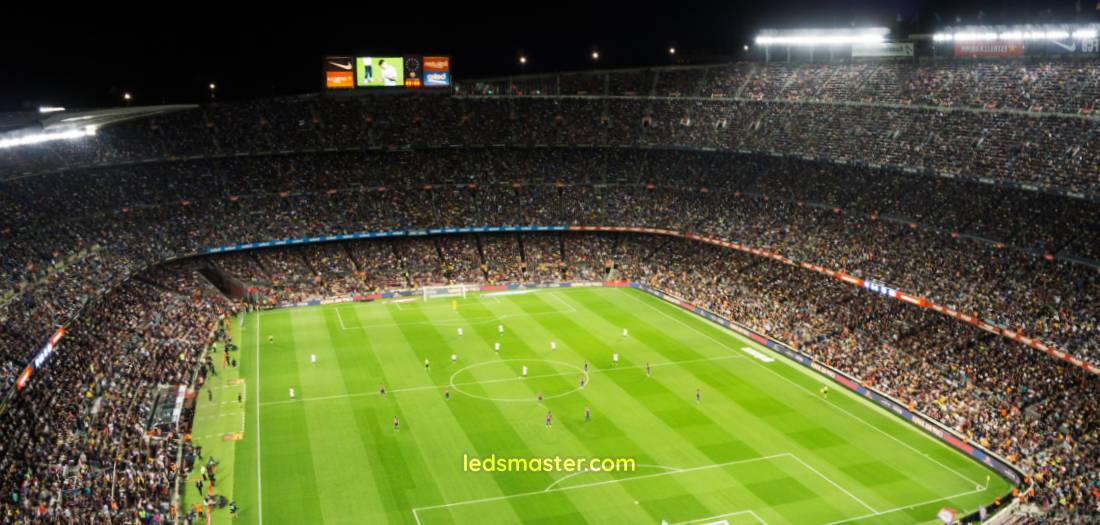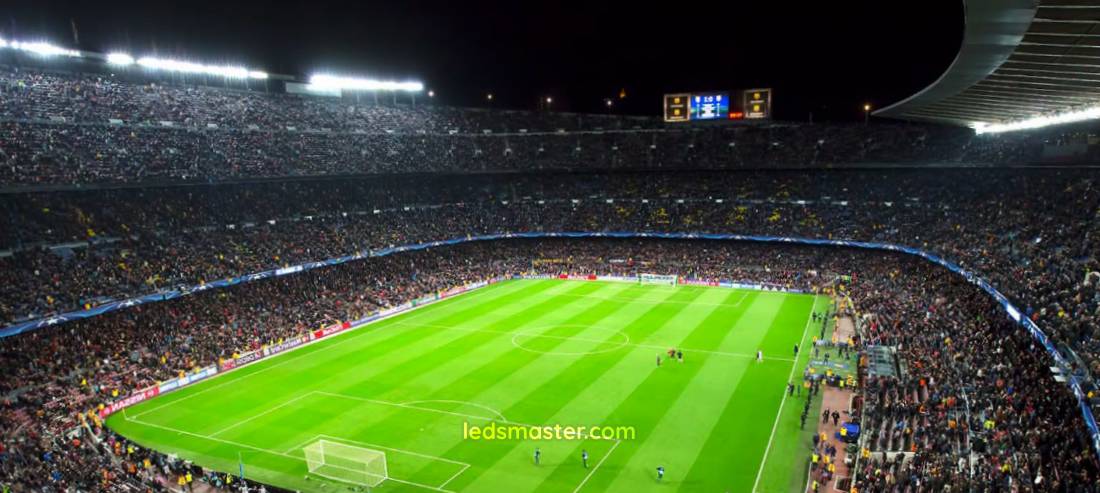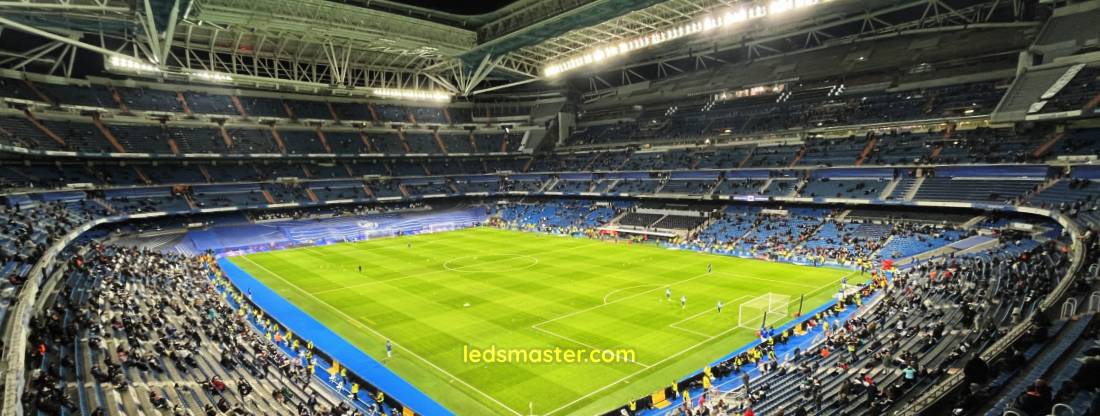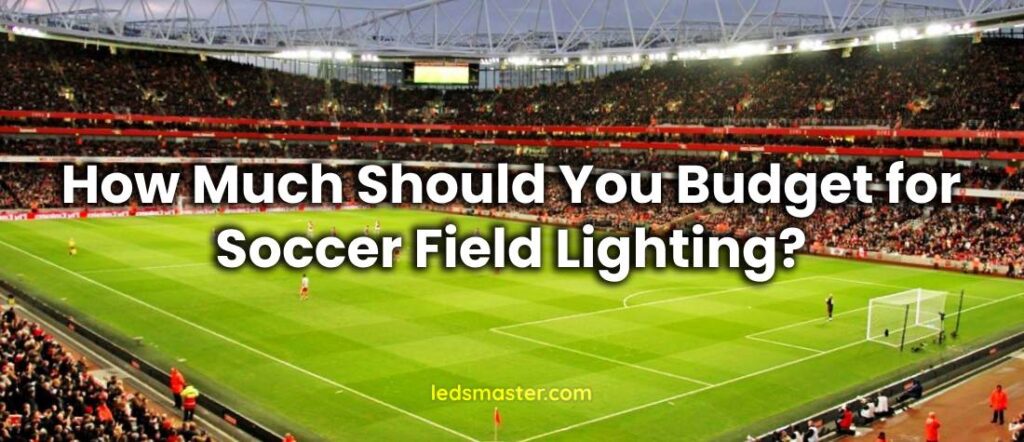Lighting a soccer field involves several considerations that influence the overall budget. The amount needed depends on various factors such as the size of the field, the number of lights, mounting height, and the type of lighting technology chosen. Understanding these elements helps in estimating the financial outlay for effective illumination that supports safe play and good visibility during evening matches or training sessions.
Table of Contents
ToggleCost of Various Types of Soccer Field Lighting
The choice of lighting technology plays a major role in shaping the overall budget for soccer field lighting projects. Different types of lamps vary widely in terms of energy efficiency, lifespan, initial purchase price, installation complexity, and ongoing maintenance needs. Understanding these differences helps in selecting the right lighting solution based on both performance expectations and financial considerations.
| Lighting Type | Wattage per Fixture | Lifespan (Hours) | Initial Fixture Cost | Energy Consumption | Maintenance Cost | Special Features / Notes |
|---|---|---|---|---|---|---|
| Metal Halide | 400 – 2000 W | 6,000 – 15,000 | $200 – $600 | High (approx. 1 kWh per hour) | Moderate ($50-$150 per bulb replacement) | Warm-up time 5-10 min; good color rendering; high energy use |
| High-Pressure Sodium (HPS) | 300 – 1000 W | 12,000 – 24,000 | $150 – $500 | Medium (30% less than metal halide) | Moderate ($40-$100 per bulb) | Lower color quality; gradual light degradation |
| Mercury Vapor | 175 – 1000 W | 8,000 – 12,000 | $100 – $300 | High | Moderate ($30-$70 per bulb) | Less efficient; shorter lifespan; being phased out |
| LED | 200 – 1000 W | 50,000 – 100,000 | $600 – $2,500 | Low (50-70% less than metal halide) | Low (<$100 annually) | Instant start; excellent color rendering; supports smart controls; rebates available |
Metal Halide Lights
Metal Halide Lights have been a longstanding favorite in sports lighting due to their ability to produce bright, white light with excellent color rendering. This makes them suitable for sports fields where clarity and visibility are critical. Metal halide fixtures typically consume between 400 watts and over 2000 watts per lamp, depending on the fixture’s size and output. The average power consumption for a mid-range fixture is around 1000 watts. While the initial cost of purchasing metal halide lamps and fixtures usually ranges from $200 to $600 per unit, operational costs can be significant. Bulbs need replacement every 6,000 to 15,000 hours, with replacement bulbs costing approximately $50 to $150 each. Energy costs for metal halide systems can add up to $1,000 to $2,500 annually per field depending on usage, considering that these lamps consume around 1 kilowatt-hour (kWh) per hour of operation. Additionally, metal halide lamps require a warm-up period of about 5 to 10 minutes to reach full brightness.
High-Pressure Sodium (HPS) Lamps
High-Pressure Sodium (HPS) Lamps offer better energy efficiency compared to metal halide, consuming approximately 300 to 1000 watts per fixture. Their bulbs last longer, typically between 12,000 and 24,000 hours, with replacement bulbs priced around $40 to $100 each. HPS lamps have a lower upfront fixture cost, often between $150 and $500, which appeals to budget-conscious projects. Despite this, the yellow-orange light produced by HPS has a color rendering index (CRI) of about 22 to 25, which is much lower than metal halide or LED lighting and may impact visibility and color distinction on the field. Energy consumption is about 30% lower than metal halide, resulting in annual electricity savings of $300 to $1,000 depending on field size and usage. However, light output from HPS lamps diminishes gradually over their lifespan, potentially requiring more frequent maintenance or early replacements to maintain lighting quality.
Mercury Vapor Lamps
Mercury Vapor Lamps are largely outdated but were once common due to low initial costs, typically $100 to $300 per fixture. They consume between 175 watts and 1000 watts per lamp but suffer from poor energy efficiency and a short lifespan of around 8,000 to 12,000 hours. Replacement bulbs cost approximately $30 to $70. Mercury vapor lamps also have high energy consumption, leading to annual electricity costs ranging from $1,500 to $3,000 per field, depending on hours of operation. Their lumen depreciation and slow warm-up times make them less suitable for modern sports lighting, and environmental regulations increasingly restrict their use.
LED Lighting Systems

LED Lighting Systems have revolutionized sports lighting and become the preferred option for new soccer field installations and upgrades. LEDs consume between 200 watts and 1000 watts per fixture but deliver the same or higher light output as traditional lamps. For example, a 400-watt LED fixture can replace a 1000-watt metal halide lamp while producing comparable illumination levels. The initial cost of LED fixtures varies from $600 to $2,500 per unit, depending on wattage and features. However, LEDs have an exceptional lifespan of 50,000 to 100,000 hours, drastically reducing replacement frequency. Maintenance costs are minimal, often less than $100 annually per field. Energy consumption for LED systems is about 50 to 70 percent less than metal halide equivalents, which translates to electricity savings of $1,200 to $3,000 per year for a typical soccer field used 6 to 8 hours daily. LEDs also provide nearly instant start-up with no warm-up time, improving operational flexibility.
Advanced LED Features and Incentives
Advanced LED systems support smart controls such as dimming, motion sensors, and remote monitoring, which can reduce energy use by an additional 20 to 40 percent. The cost of adding these control systems ranges from $1,000 to $5,000 depending on complexity and features. Furthermore, many utilities offer rebates of $10 to $50 per fixture for upgrading to LEDs, helping offset initial costs. Falling LED prices and increasing efficiency have made them a cost-effective investment with payback periods often ranging from 2 to 5 years, depending on usage and energy rates.
Comparing Total Cost of Ownership
When evaluating lighting technologies, it is crucial to consider both upfront expenses and total cost of ownership, including energy consumption, maintenance, and possible financial incentives. For instance, a soccer field lighting project using metal halide lamps might cost $40,000 upfront with annual operating costs around $4,000, while an equivalent LED system could require a $70,000 initial investment but only $1,500 per year to operate and maintain. Over a 10 to 15-year period, the LED system often proves more economical despite the higher initial price due to substantial energy and maintenance savings.
Factors Affecting Soccer Field Lighting Cost
Number of Lights Required

One of the main drivers of the cost for soccer field lighting is the number of lights required to adequately illuminate the playing area. The size of the field plays a significant role in determining how many fixtures are needed. A standard full-size soccer field, which typically measures about 100 meters in length and 60 meters in width, can require anywhere from 20 to 40 individual lamps depending on the lighting layout, the type of fixtures used, and the desired brightness level. For community or recreational fields where the lighting requirements are more modest, fewer lights may be sufficient. However, professional or tournament-level fields often need a higher lighting standard, which can push the number of fixtures toward the upper end of that range or beyond. For example, professional fields used for evening matches often aim for an average illumination level of 500 to 750 lux, which demands more lamps and stronger light output compared to recreational fields that may only require around 200 lux.
Pole Height and Installation Costs
The mounting height of the light poles also directly influences the cost of the lighting system. Typically, poles range from 30 feet (approximately 9 meters) to 60 feet (around 18 meters) or taller, depending on the field layout and the type of lighting technology chosen. Taller poles are often necessary to reduce glare and avoid harsh shadows on the field, but they come with increased manufacturing and installation costs. The price of poles can vary widely, with shorter poles costing between $1,000 and $3,000 each, while taller poles—those 50 to 60 feet in height—may cost $5,000 to $10,000 or more per unit. Installation costs also rise with pole height because cranes or specialized equipment are required, and foundations must be stronger and deeper to support the increased load. Labor costs can increase by 30 to 50 percent for higher poles due to these additional requirements. Furthermore, taller poles often require more powerful lighting fixtures to cover the same area, which can push lamp costs from $500 per fixture for lower wattage models to $2,000 or more for high-output units designed for greater throw distances.
Quality of Mounting Hardware and Controls
The choice and quality of mounting hardware also contribute to the overall expense. Components such as brackets, wiring, conduits, and control systems vary in price depending on their durability, weather resistance, and ease of maintenance. Higher-grade materials built to withstand harsh outdoor conditions tend to cost more upfront but can reduce maintenance expenses over the system’s lifespan. Lighting control systems, including smart dimming, motion sensors, or remote monitoring, add to the initial cost but provide the benefit of lowering energy consumption over time. For example, a basic manual control panel might cost a few hundred dollars, whereas an advanced smart control system with wireless monitoring can add $2,000 to $5,000 or more to the project budget.
Local Regulations and Permitting
Local regulations and permit requirements are additional factors that impact the budget for soccer field lighting. Many municipalities impose restrictions on light pollution, including limits on how far light can spill beyond the field boundaries, maximum allowed brightness, and height restrictions on poles. Compliance with these rules may require specialized lighting fixtures designed to minimize glare and light trespass, or additional shielding and aiming techniques, which can increase costs by 10 to 20 percent. Permit fees and inspections also add to the upfront expenses and vary by location. For instance, permit fees for lighting installations can range from a few hundred dollars in smaller communities to several thousand dollars in larger cities with stricter regulations.
How to Save Money on Soccer Field Lighting
Planning and Design Optimization

Reducing expenses related to soccer field lighting starts well before any equipment is purchased or installed. Careful and detailed planning plays a major role in controlling costs. Designing the lighting layout with the goal of minimizing the number of fixtures while still achieving uniform and adequate illumination can significantly lower both the initial capital outlay and the ongoing operational expenses. An inefficient layout that overuses fixtures or places poles unnecessarily can lead to excessive upfront costs and higher energy consumption over the system’s lifetime. Engaging with experienced lighting designers or engineers who specialize in sports facility lighting helps ensure that the installation meets the required standards without overspending. These professionals can recommend the best placement, angles, and types of fixtures to balance light coverage with cost-efficiency.
Selecting Appropriate Lighting Technologies
Selecting the appropriate lighting technology for the specific use case of the field is another effective way to save money. Community fields or school facilities, which often operate on tighter budgets and have lower lighting intensity needs, might find a hybrid lighting approach practical. This could mean combining more affordable traditional lighting options with a few LED fixtures to optimize both upfront costs and long-term energy savings. In contrast, venues with longer hours of use or those hosting professional matches may benefit from investing more heavily upfront in a full LED system. While LEDs often come with a higher initial price tag—sometimes two to three times the cost of conventional lamps—their superior energy efficiency and extremely long lifespan (often 50,000 to 100,000 hours) can deliver substantial savings over a period of 10 to 15 years. These savings come from both reduced electricity bills and lower maintenance requirements, which can more than compensate for the higher initial investment.
Incorporating Energy-Saving Controls
Incorporating energy-saving technologies such as timers, motion sensors, and dimming controls into the lighting system adds another layer of cost efficiency. These features allow the lights to be activated only when necessary and at brightness levels appropriate for the activity being conducted. For example, during practice sessions or casual games, lighting levels can be reduced through dimming, which directly cuts energy consumption. Motion sensors ensure that lights turn on only when people are present on or near the field, preventing unnecessary power use during unoccupied periods. Timers can automate lighting schedules to match typical usage patterns, avoiding lights being left on accidentally after events conclude. Using these controls can reduce energy expenses by 20 to 40 percent and extend the lifespan of the lamps by preventing overuse.
Utilizing Financial Incentives
Exploring available financial incentives can also help lower the overall cost of soccer field lighting upgrades. Many governments, municipalities, and utility providers offer rebates, grants, or tax credits designed to encourage the adoption of energy-efficient lighting solutions. These incentives can reduce the net cost of installing LED fixtures or integrating smart control systems by 10 to 30 percent or more. It is worthwhile for project planners and facility managers to research and apply for such programs, which vary widely by region and utility provider. Some programs also provide free or discounted energy audits and consultations, helping facilities identify the most cost-effective ways to reduce consumption and improve overall efficiency.
Maintenance and Longevity Savings
Maintenance savings can be realized by investing in durable lighting equipment with longer service lives and by implementing a proactive maintenance schedule. Regular inspections and preventative maintenance can catch small issues before they develop into costly repairs or require premature replacements. LED lighting, in particular, tends to reduce maintenance demands because these fixtures rarely need bulb replacements within the typical 10-15 year operating period. In contrast, traditional lighting options such as metal halide or high-pressure sodium lamps often require bulb changes every 1,000 to 3,000 hours, which can add significant labor and material costs over time. Scheduling maintenance during off-peak hours or seasons can also minimize disruptions to field availability, which helps maximize facility usage and associated revenue.
Combining Lighting with Other Facility Upgrades
An integrated approach to energy savings may involve combining lighting upgrades with other facility improvements. For instance, installing solar panels on-site can reduce the facility’s reliance on grid electricity and provide clean, renewable power to run the lighting system. Solar installations can be sized to meet a portion or all of the field’s energy demand, which reduces electricity bills and mitigates exposure to fluctuating energy prices. Coupling energy-efficient lighting with other measures such as upgrading electrical infrastructure, using smart energy management systems, and optimizing building envelope efficiency further enhances savings and sustainability. In some cases, facilities have reported reductions in energy costs by up to 50 percent when combining these strategies.
Balancing Costs and Performance
Ultimately, lighting a soccer field involves balancing upfront capital costs with ongoing operating expenses. By carefully considering factors such as the number of fixtures, the height and type of poles, the choice of lighting technology, and the use of advanced controls, facility owners and operators can craft solutions that align with their budgets and performance expectations. Proper planning, strategic technology choices, and attention to maintenance and energy management all contribute to lowering total cost of ownership. This approach not only helps make lighting more affordable but also improves the quality and reliability of illumination for players, coaches, and spectators alike.
Final Thoughts
Budgeting for soccer field lighting involves understanding how variables such as field size, lighting technology, and installation logistics shape the total cost. LED systems present a modern solution with higher efficiency and longer lifespan.
Thoughtful planning, leveraging smart technology, and exploring incentives can all help reduce the financial impact of lighting a soccer field. By focusing on long-term value rather than just initial cost, facilities can build a lighting system that performs well and supports future demands.

